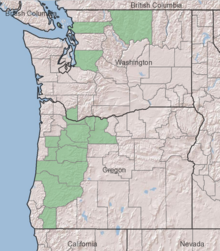| Symphyotrichum hallii | |
|---|---|

| |
| Conservation status | |
 Apparently Secure (NatureServe) | |
| Scientific classification | |
| Kingdom: | Plantae |
| Clade: | Tracheophytes |
| Clade: | Angiosperms |
| Clade: | Eudicots |
| Clade: | Asterids |
| Order: | Asterales |
| Family: | Asteraceae |
| Tribe: | Astereae |
| Subtribe: | Symphyotrichinae |
| Genus: | Symphyotrichum |
| Subgenus: | Symphyotrichum subg. Symphyotrichum |
| Section: | Symphyotrichum sect. Occidentales |
| Species: | S. hallii |
| Binomial name | |
| Symphyotrichum hallii (A.Gray) G.L.Nesom | |

| |
| Native distribution | |
| Synonyms | |
| |
Symphyotrichum hallii (formerly Aster hallii) is a species of flowering plant in the family Asteraceae endemic to western Oregon and Washington states. Commonly known as Hall's aster, it is a perennial, herbaceous plant with a long rhizome that creates colonies of itself. It grows about 30–60 centimeters (1–2 feet) tall, and has white (sometimes pale violet) rays that open July–August.
Most occurrences of the species have been found at elevations of 0–500 meters (0–1,640 feet) in open areas in the Puget Sound region and Willamette Valley, with outliers in Columbia Gorge and central Washington. It is conservationally Imperiled (S2) in Washington state.
Citations
References
- Brouillet, L.; Semple, J.C.; Allen, G.A.; Chambers, K.L.; Sundberg, S.D. (2006). "Symphyotrichum hallii". In Flora of North America Editorial Committee (ed.). Flora of North America North of Mexico (FNA). Vol. 20. New York and Oxford: Oxford University Press. Retrieved 3 July 2021 – via eFloras.
- NatureServe (2 July 2021). "Symphyotrichum hallii Hall's Aster". explorer.natureserve.org. Arlington, Virginia. Retrieved 3 July 2021.
- POWO (2019). "Symphyotrichum hallii (A.Gray) G.L.Nesom". Plants of the World Online. Royal Botanic Gardens, Kew. Retrieved 3 July 2021.
- USDA, NRCS (2014). "Symphyotrichum hallii". PLANTS Database. United States Department of Agriculture (USDA). Retrieved 2 September 2021.
| Taxon identifiers | |
|---|---|
| Symphyotrichum hallii |
|
| Aster hallii | |
This Astereae article is a stub. You can help Misplaced Pages by expanding it. |